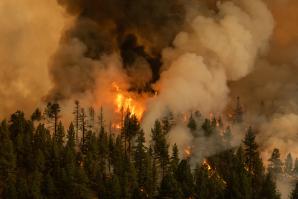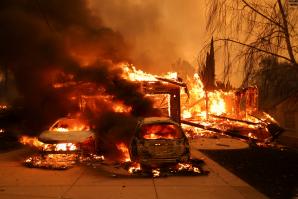According to the California Department of Forestry and Fire protection (better known as Cal Fire), more than 7,000 wildfires over 10 acres have burned across the state this year. September is part of peak fire season for California, though “peak” is a dubious term for a period that stretches nearly half the year — a recent study in the journal Science Advances found that fire season now stretches from late spring until October or November.
Some may not know that the National Weather Service plays a major role in helping California manage wildfires by providing specialized weather support before, during and after fire events. Their contributions include daily fire weather forecasts, which include factors such as temperature, wind speed and lightning potential that help fire managers issue Red Flag Warnings; real-time monitoring with satellites and surface weather stations; and public safety alerts, which are pushed out through TV, radio and mobile alerts.
During the evaluation of NOAA’s Fire Weather Testbed, members of
Cal Fire and the NWS form a simulated Integrated Warning Team to
detect new fires, respond to them, and collaborate on issuing
Fire Warnings. (Public domain photo by NOAA via Wikimedia
Commons)

As the fire season began in earnest this summer, it seemed as though local NWS stations in Sacramento and Hanford would not have the staff necessary to maintain these critical functions. While neither station currently has any listed vacancies on USAJobs, the federal government’s employment website, Sacramento had eight vacancies across 16 meteorologist positions in July. Hanford, meanwhile, had the worst vacancy rate in the country (tied with Goodland, Kansas), at 62 percent, the Los Angeles Times reported.
The Sacramento and Hanford NWS offices cover the region from Redding to Bakersfield, including Yosemite, Sequoia, Lassen and King’s Canyon national parks. After several layoffs in February — in which the Department of Government Efficiency terminated 500 employees across the NWS — and two separate early retirement offers, both offices became critically short of meteorologists.
In April of 2025, the impacts of the staffing cut began to show. The Sacramento NWS office emailed partners to inform them that it would no longer answer public phone calls, would update its social media less often and would reduce staffing levels overnight. It also said that it would be cutting from twice daily forecasts to just one forecast every 24 hours and that this reduction would include the crucially important fire weather forecasts.
Tom Fahey, legislative director for the National Weather Service Employees Organization, explained to Comstock’s in July that some vacancies are common, but these levels were unprecedented. “The Sacramento office had a 21 percent vacancy rate prior to the Trump administration,” Fahey said. “After the buyouts … of the early Trump administration, then the Sacramento office was at 37 percent vacancy rates.”
But among the meteorologists, who do the crucial work of forecasting the weather, vacancies were even higher. Three of six lead forecaster jobs were then vacant, according to Fahey. The office was also working with only five of the 10 forecasters, who work under the lead forecasters to ensure accurate and reliable forecasting. In early August, a lead forecaster from elsewhere in the U.S. accepted an offer to transfer to Sacramento, reducing the shortage to one lead forecaster.
As Fahey explained, “the National Weather Service is the foundation of all weather data in the United States.” It provides data, for free, to broadcast outlets, newspapers and private sector weather forecasting companies.
“Because of the reduced staffing circumstances,” Fahey said, “the NWS leadership has put together a buddy system.” This means offices in Reno, Eureka and Monterey are monitoring the region, preventing blind spots and gaps in coverage. They use the same satellite data and weather modeling that Sacramento based meteorologists would use.
Weather coverage impacts much more than the forecast that helps you decide what to wear. NWS offices provide warnings for life threatening weather emergencies, such as flash floods, blizzards and wildfires. During fires, their information helps fire crews battle the flames and protect property and life, and local authorities to evacuate areas before there is a risk to people living there. The NWS also issues heat warnings, which can allow people who are vulnerable to high temperatures, don’t have air conditioning or live outside time to find a cooling location.
National Weather Service Incident Meteorologist Ryan Walbrun
briefs the CalFire Incident Management Team on smoke trajectory
and impacts while deployed for the Park Fire. (Public domain
photo by NOAA via Wikimedia Commons)

Californians often rely on forecasting to alert them to high fire risk days and the movement of fires. Fahey said the NWS staff will do their best to keep these vital safety reports available. When fires break out, the NWS embeds iMets (incident Meteorologists) with firefighters. “We deploy meteorologists to work on the Fireline alongside the firefighters,” Fahey said. These meteorologists predict weather on the ground, and help protect firefighters from burnovers and other weather related risks.
Fahey did see some hope on the horizon. In January, President Trump announced a 90-day hiring freeze of all vacant civilian and contract positions in the federal government. But NWS personnel were exempted from hiring freezes by a July Executive Order, and the agency was approved to hire 450 new staff. Fahey chalked this victory for the NWS up to the hard work of California Representative Jimmy Panetta, who helped introduce a bipartisan bill to protect the NWS, and the pressure legislators across the country felt from their constituents in town halls and at their offices to ensure that the NWS could fulfill its vital public safety function.
A fire danger signpost in the Malibu recreational area on Las
Virgines Canyon in January 2025. (Shutterstock photo)

Other representatives were also at work to support NWS and its parent organization, the National Oceanic and Atmospheric Administration. While the White House 2026 budget proposal recommended cutting $2.2 billion from NOAA, the fiscal 2026 Commerce-Justice-Science spending bill that the House Appropriations Committee approved in September included amendments protecting NOAA laboratories and university-based cooperatives that provide weather and climate research, Politico reports. It specifically requires NOAA to advance early prediction and warning systems for floods in rural areas, among other research subjects.
The spending bill also alludes to NOAA and NWS staffing issues, noting that the NOAA administrator, “in consultation with the employees of the National Weather Service and non-governmental experts in personnel management,” may establish an alternative or fixed rate for relocation allowance or permanent change of station allowance. This would allow NOAA to create special relocation rules for NWS employees to prevent critical understaffing from happening again.
The Senate’s version of the Commerce-Justice-Science spending bill has even more specific directives on NOAA and NWS staffing and funding, including $1,253,661,000 for NWS. The Senate and House versions must be approved by their respective chambers and reconciled before the resulting bill can be sent to the president’s desk to be signed into law.
Whether or not the local NWS offices remain fully staffed, fire remains a risk for Californians. Flooding is also a threat in Central Valley cities like Sacramento and Stockton, as Comstock’s previously reported. Fahey suggests every household invest in a Weather and Emergency Alert Radio. The National Oceanic and Atmospheric Administration issues radio weather reports and emergency alerts across all of California, and these radios can be configured to turn on only when there is an emergency alert in the user’s area. “They (NOAA) transmit weather and weather emergency information,” Fahey said, “and that information is free.”
–
Subscribe to the Comstock’s newsletter today.
Recommended For You

Earth, Wind and the Fire Next Time
Climate change is a factor in California’s rampaging wildfires, but not the only one
Due to human influence, three primary ingredients of wilderness fires are on the rise: the accumulation of biofuels in the forest, rising heat of the planet as a whole, and an ineffective political system of fire management.

After the Fire
A muralist and photographer team up to paint and memorialize the ruins of the Camp Fire in Paradise
Artist Shane Grammer knew he had to paint the brick chimney the moment he saw a photo of it — the only part of a friend’s house in Paradise still standing after the Camp Fire devastated the town. The fire started tearing through the area on Nov. 8, 2018, becoming the deadliest and most destructive wildfire in California history.

The Soaring Cost of Homeowners Insurance
High prices and carriers leaving the state send homeowners scrambling to protect their homes
California’s insurance crisis is damaging the housing market and more. Will legislators fix it before the next big blaze?

How Is California Fire-Proofing for the Future?
From flame-resistant building materials to increased defensible space, our future homes and neighborhoods may look vastly different
In an era of escalating fire disasters, with insurers fleeing large parts of the state and with builders desperate to find ways to construct houses that would better resist the flames, what can we do to defend our neighborhoods?

Some Burning Questions on Wildfires
FROM THE PUBLISHER: As it is with all catastrophes, there’s plenty of blame to go around. I guess this can be a useful exercise at some point, but it won’t rebuild people’s homes, restore their most valued possessions or, most importantly, stop this from becoming an annual, recurring heartbreak. We need to ask and answer some obvious questions.



